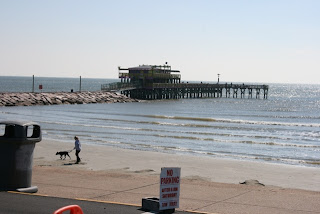On Monday, we finally ventured out on a sightseeing
excursion to the Johnson Space Center.
We arrived after our hour drive just as the gates were opening for
visitors.
We were able to jump on the
first Tram Tour after going through security checkpoint.
 |
| Mike, Joanne, and Susan waiting for Tram to start. |
The Johnson Space Center occupies more than
1,600 acres and employs more than 14,000 people including contractors and civil
servants.
The first stop on the very
chilly ride (we did not really come prepared for an open vehicle ride with
temps hovering around 50) was the Christopher C. Kraft Jr. Mission Control
Center.
For those of us who remember the
entire history of space flight, the viewing of Mission Control brought back
memories of watching the mission control activity on TV.
Our second stop was at the Space Vehicle
Mockup Facility which, I believe, is/was used as a training facility for the assembly
of the International Space Station.
I
think the most interesting fact about the Tram Tour was the explanation given
for the cessation of the Shuttle program.
The program in the later years was intended to be used primarily for the
construction of the International Space Station with the shuttle transporting
parts during the construction.
I always
thought that the shuttle would be used to transport crew members to and from
the Space Station.
That was not its
purpose and it would be like taking a big Mac truck to your job each day.
The final stop of the outdoor tour was the
Saturn V Complex at Rocket Park.
Inside
the building is a full-size model of the Saturn V rocket which sent the
astronauts into space for the trips to the moon.
 |
| Joanne, Mike, and Susan outside the Saturn V Complex |
 |
| Joanne, Mike, and Pat in front of one section of Saturn V Rocket |
 |
| Banners representing each of Apollo Flights. |
 |
| View of entire length of Saturn V Rocket. |
After returning to the visitor’s center and eating a very
expensive lunch (we were a captive audience with a choice of eating lunch for
$20 or going hungry), we visited several of the attractions.
The first presentation was “Living in Space”
which had a mockup of the living quarters on the International Space
Station.
The narrator showed us how one
sleeps, eats, and other daily aspects of living in a weightless
environment.
Another demonstration was
the current NASA mission to Mars with a laboratory called Curiosity Rover.
This mission was launched in November 2011
with touchdown scheduled on Mars in early August 2012.
The rover will assess whether Mars ever was,
or is still today, an environment able to support microbial life.
If you think NASA is idle, visit
http://www.nasa.gov/missions/index.html
for a description of past, current and future missions.
The final attraction we visited was Starship Gallery Museum
which contains artifacts from the years of space exploration.
“This incredible collection includes: an
original model of the Goddard Rocket; the actual Mercury Atlas 9 "Faith
7" capsule flown by Gordon Cooper; the Gemini V Spacecraft piloted by Pete
Conrad and Gordon Cooper; a Lunar Roving Vehicle Trainer, the Apollo 17 Command
Module, the giant Skylab Trainer, and the Apollo-Soyuz Trainer.” (
http://space.about.com/cs/nasa/p/jscvisit.htm)
 |
| Lunar Roving Vehicle Trainer |
 |
| Lunar Lander Trainer |
 |
| Susan in Shuttle cockpit |
Yesterday (Thursday), we decided to drive to the Reliant
Center for the Houston RV Show. The
center is in the complex with the Astrodome and the new Reliant stadium for the
Texans. Because we are staying north of
Houston and the Reliant complex is south of downtown, we drove straight through
the downtown area. I must say that the
roads in and around Houston are fairly easy to maneuver and we made it there
and back without getting lost (OnStar helps, too!).
 |
| Downtown Houston |
 |
| Minute Maid Stadium-Home of Houston Astros Baseball Team |
 |
| Reliant Stadium-Home of Houston Texans NFL Team |
 |
| Astrodome-Not currently in use. |
The RV show was kind of small as RV shows go
with only dealers represented. We did
attend a seminar on converting RV Refrigerator (absorption type) to a regular
residential refrigerator. More and more
RVs are being equipped with residential refrigerators. The traditional RV refrigerator has a fire
hazard because it uses heat to cool (as I understand it) plus the refrigerator
never really stays as cold as a residential model. I think we will probably look into converting
our fridge at some point in the future.
Today has been another rainy day so our next sightseeing
excursion will probably be early next week.
Pat’s brother and wife are still next door to us and we are enjoying
their company.
EASY LIVING!!























































